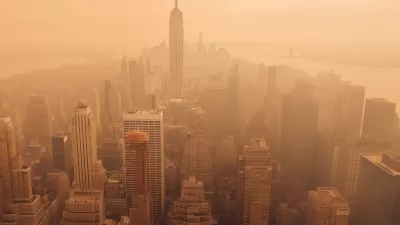A new study reveals two findings on air pollution spewing from China's coal-burning factories. First, the pollution blows to the U.S and other nations. Second, 20% of the pollution can be traced to Western demand for cheap goods from those factories.
"About one-fifth of the pollution China spews into the atmosphere comes from producing goods for export to the United States and other countries, according to the paper [PDF] by a group of scientists that was published [Jan. 20] in the Proceedings of the National Academy of Sciences (PNAS)," writes Tony Barboza.
In six days, winds can blow the smog and particulates that cloak China's eastern cities to the U.S and "spread pollution levels over the West Coast of up to 75 percent of federal standards," writes John Metcalfe of The Atlantic Cities.
These transported pollutants explain why air pollution levels "have remained at a high level during 2000–2009 even as emissions produced in the United States, Europe, and Japan have decreased,” the scientists wrote.
The paper is a reminder that U.S. demand for cheap imports from China has a way of blowing those environmental problems back at us, said Steve Davis, an Earth system scientist at UC Irvine and co-author of the study.
In The New York Times, Edward Wong writes that Jintai Lin, a professor in the department of atmospheric and oceanic sciences at Peking University’s School of Physics and lead author of the paper, "said he hoped that the research would stimulate discussion of adopting consumption-based accounting of emissions, rather than just production-based accounting."
Davis went beyond air pollution and linked the report to climate change, expressing "hope that the findings would be used by world governments working to craft international agreements to limit emissions of carbon dioxide...as well as short-lived air pollutants that are responsible for poor air quality around the globe."
Wong notes that last July, PNAS "published a paper by other researchers that found a drop in life spans in northern China because of air pollution," also posted here.
FULL STORY: China's industry exporting air pollution to U.S., study says

Study: Maui’s Plan to Convert Vacation Rentals to Long-Term Housing Could Cause Nearly $1 Billion Economic Loss
The plan would reduce visitor accommodation by 25,% resulting in 1,900 jobs lost.

North Texas Transit Leaders Tout Benefits of TOD for Growing Region
At a summit focused on transit-oriented development, policymakers discussed how North Texas’ expanded light rail system can serve as a tool for economic growth.

Why Should We Subsidize Public Transportation?
Many public transit agencies face financial stress due to rising costs, declining fare revenue, and declining subsidies. Transit advocates must provide a strong business case for increasing public transit funding.

How to Make US Trains Faster
Changes to boarding platforms and a switch to electric trains could improve U.S. passenger rail service without the added cost of high-speed rail.

Columbia’s Revitalized ‘Loop’ Is a Hub for Local Entrepreneurs
A focus on small businesses is helping a commercial corridor in Columbia, Missouri thrive.

Invasive Insect Threatens Minnesota’s Ash Forests
The Emerald Ash Borer is a rapidly spreading invasive pest threatening Minnesota’s ash trees, and homeowners are encouraged to plant diverse replacement species, avoid moving ash firewood, and monitor for signs of infestation.
Urban Design for Planners 1: Software Tools
This six-course series explores essential urban design concepts using open source software and equips planners with the tools they need to participate fully in the urban design process.
Planning for Universal Design
Learn the tools for implementing Universal Design in planning regulations.
City of Santa Clarita
Ascent Environmental
Institute for Housing and Urban Development Studies (IHS)
City of Grandview
Harvard GSD Executive Education
Toledo-Lucas County Plan Commissions
Salt Lake City
NYU Wagner Graduate School of Public Service





























